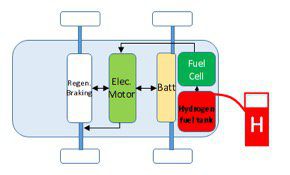Fuel Cell Electric Vehicles (FCEV) are technically very similar to a battery electric vehicle (BEV), but swap out a sizeable chunk of the battery and replace it with two components: a hydrogen fuel storage tank, and a reaction chamber called a fuel cell.
They are also similar to a hybrid EV, in that the do not plug-in to directly recharge the battery – rather, they are refuelled using hydrogen bowsers that are similar in appearance to LPG ones.
It is also worth noting that whilst FCEVs are sometimes called ‘hydrogen cars’, they do not burn hydrogen in the way that internal combustion engines do: rather, FCEVs operate by using a hydrogen reaction inside the fuel cell to generate electricity for the motor.
As a result, FCEVs are technically an EV, not an internal combustion engine, and the exhaust gas from an FCEV is pure water vapour.
The battery in an FCEV still does the heavy lifting though; both in terms of regenerative braking (fuel cells cannot be ‘recharged’ except by adding more hydrogen), and in terms of acceleration (fuel cells do not cope with sudden heavy demands).
Note that no FCEVs are currently available for sale in Australia, although some demonstration FCEV vehicles are being leased to chosen businesses and Government departments.

Bryce Gaton is an expert on electric vehicles and contributor for The Driven and Renew Economy. He has been working in the EV sector since 2008 and is currently working as EV electrical safety trainer/supervisor for the University of Melbourne. He also provides support for the EV Transition to business, government and the public through his EV Transition consultancy EVchoice.

